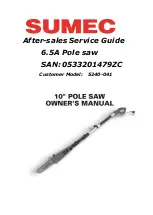
21
MAINTENANCE
WARNING:
When servicing, use only identical
replacement parts. Use of any other part may create
a hazard or cause product damage.
WARNING:
Always wear safety goggles or safety
glasses with side shields during power tool operation
or when blowing dust. If operation is dusty, also wear
a dust mask.
GENERAL
Avoid using solvents when cleaning plastic parts. Most
plastics are susceptible to damage from various types of
commercial solvents and may be damaged by their use.
Use clean cloths to remove dirt, carbon dust, etc.
WARNING:
Do not at any time let brake fluids,
gasoline, petroleum-based products, penetrating
oils, etc. come in contact with plastic parts. Chemi-
cals can damage, weaken or destroy plastic which
may result in serious personal injury.
It has been found that electric tools are subject to
accelerated wear and possible premature failure when
they are used on fiberglass boats, sports cars, wallboard,
spackling compounds, or plaster. The chips and grindings
from these materials are highly abrasive to electric tool
parts such as bearings, brushes, commutators, etc.
Consequently, it is not recommended that this tool be
used for extended work on any fiberglass material, wall-
board, spackling compounds, or plaster. During any use
on these materials it is extremely important that the tool is
cleaned frequently by blowing with an air jet.
n
Keep your band saw clean.
n
Remove sawdust from the inside frequently.
n
Do not allow pitch to accumulate on the saw table, blade
guides, or thrust bearings. Clean them with gum and pitch
remover.
n
Apply a thin coat of automobile type wax to the saw
table’s top so the wood slides easily while cutting.
LUBRICATION
All of the bearings in this tool are lubricated with a suffi-
cient amount of high grade lubricant for the life of the unit
under normal operating conditions. Therefore, no further
lubrication is required.
WARNING:
To ensure safety and reliability, all
repairs — with the exception of the externally acces-
sible brushes — should be performed by a qualified
service technician at a Sears store to avoid risk of
personal injury.
Fig. 20
BLADE GUARD REMOVED
FOR CLARIFICATION ONLY
BLADE GUIDE
SUPPORT SCREW
BLADE GUIDES
THRUST
BEARING
SCREW
THRUST
BEARING
BLADE GUIDE
ASSEMBLY
UPPER BLADE
GUIDE SUPPORT
TIRES
Cleaning tires:
n
Pitch and sawdust accumulates on tires and needs to be
removed with a fine wire brush or a piece of wood.
Do
not
use a sharp knife or any kind of solvent.
Replacing tires:
n
Open front cover and remove saw blade. See section on
Installing and Adjusting the Blade
, page 14.
n
Pry the worn tire away from the wheel carefully.
n
Stretch the new tire around the wheel.
n
Replace the saw blade and close the front cover.
BLADE GUIDES
See Figure 20.
Blade guides may become rounded and worn during use.
n
Unplug the band saw.
n
Remove the blade guides and file or grind flat.
n
Replace blade guides when filing or grinding has worn
them down and they can no longer be properly secured
in place.












































